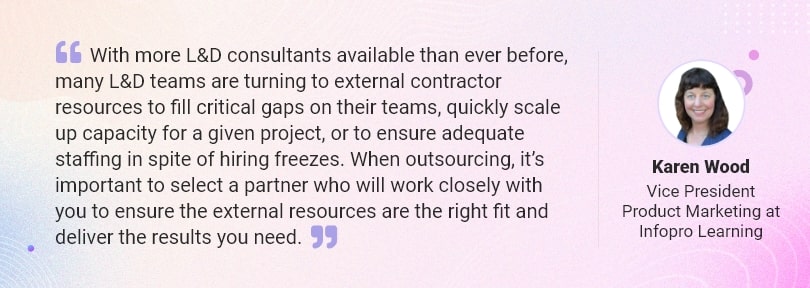Staying ahead of the competition is crucial for organizations, and the Learning and Development (L&D) industry plays a vital role in achieving this. It provides employees with the necessary skills and knowledge to perform their jobs effectively and efficiently, ultimately leading to increased productivity and profitability. However, many organizations struggle with the L&D talent gap: the shortage of skilled L&D professionals within their own workforce. Augmenting your team with consultants who have specialized skills can solve this problem, allowing organizations to access experienced resources they may not have in-house.
Outsourcing also is a cost-effective solution for large, small, and medium-sized businesses, allowing them to scale up or down their workforce as needed. By embracing outsourcing, organizations can reduce the talent gap, gain access to specialized skills, and ensure the continuous development of their employees, resulting in a more agile, competitive, and successful business.
How Can Outsourcing Help Reduce the L&D Talent Gap?
Outsourcing is an effective solution to address the talent gap in almost every industry.

Here are some ways in which outsourcing can reduce the talent gap in the L&D industry:
Access to a wider talent pool: By partnering with talent outsourcing providers, companies can access a larger pool of talent that may not be readily available in-house. This can help fill crucial roles and bring specialized skills unavailable within the organization.
Cost-effective solution for large, small and medium-sized businesses: Talent outsourcing is a good option for small and medium-sized businesses that may not have enough money to hire a full-time team of experts. By outsourcing, they can easily increase or decrease their workforce based on their needs. This helps to save money by reducing the costs of full-time employment.
Increased flexibility in hiring: Outsourcing also allows for increased flexibility in hiring, as companies can adjust their workforce to meet changing demands or project timelines. By outsourcing, companies can quickly adapt to market changes and improve their ability to compete.
Access to expert and specialized knowledge: Talent outsourcing in the L&D industry enables organizations to access the specialized knowledge and expertise of experienced professionals. This can help organizations keep up to date with the latest trends and developments and achieve improved outcomes from their L&D efforts.
Expands reach in local and global markets: Talent outsourcing providers comprehensively understand the recruitment landscape in their respective markets. They utilize a global network to meet the recruitment outsourcing requirements of their clients, leveraging the most competitive recruitment centers across the globe.
Strengthens employer branding: Talent outsourcing providers can bolster employer branding by enhancing recruitment efficiency and managing the employer brand. They have direct contact with employment markets and can help companies become more attractive to top talent who have more power in choosing where and when they want to work.
Best Practices for Successful Partnership with a Talent Outsourcing Provider
Global Industry Analysts, Inc.’s report projected that the Global Human Resource Outsourcing (HRO) market will reach $65.3 billion by 2030. Organizations must plan their requirements carefully to ensure a good partnership with a talent outsourcing provider. Here are some tips that can help:
Conduct thorough research and due diligence: Organizations should conduct thorough research before partnering with an outsourcing provider. This involves evaluating potential partners based on their experience, expertise, and reputation. When outsourcing, it’s crucial to consider whether the company you’re working with has a similar culture to yours, how you’ll communicate with them, and how they handle data security.
Establish a strong working relationship with the outsourcing partner: To achieve successful talent outsourcing, it is crucial to have a strong relationship. This involves establishing clear lines of communication, setting expectations, and developing trust. It is important to regularly communicate and provide feedback to the outsourcing partner to maintain a strong and healthy relationship.
Define clear roles and responsibilities: Clear roles and responsibilities should be established for both the outsourcing partner and the internal team. To ensure everyone is aligned and working towards the same objectives, it is essential to establish key performance indicators (KPIs) and metrics to track progress and outcomes.
Monitor progress and evaluate outcomes: Regular monitoring and evaluation are crucial to ensure the success of talent outsourcing. This involves tracking progress against established KPIs and metrics and making modifications as necessary. It is also important to evaluate the overall impact of outsourcing on the organization’s goals and objectives.
Conclusion
Leveraging talent outsourcing can be an effective solution for businesses aiming to enhance their L&D initiatives and attain their business objectives. By utilizing the proficiency of outsourcing providers, companies can access suitable L&D talent, execute efficient training programs, and establish a competitive edge in the industry.
Access premium L&D talent, including Virtual Trainers, Learning Architects, Business Analysts, Instructional Designers, Project Managers, LMS Administrators, etc., by partnering with us. Our customized engagement models will help an L&D organization augment their teams with top L&D talent on full-time, short-term contracts and as-needed basis.
We have a network of over 50,000+ trusted professionals with a broad geographical reach in 40+ countries with 20+ languages supported. Write to us at info@infoprolearning.com or drop a comment below.




